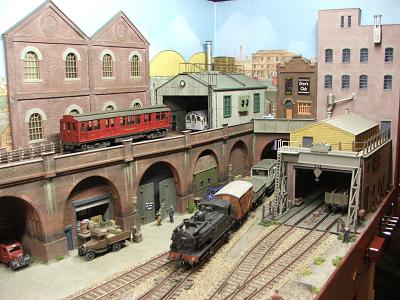Bishop Street Yard ![]()
John Long OO gauge 4mm scale
Set in the London conurbation, this small layout depicts a goods yard in a urban setting of factories, workshops and railway arch businesses. Above the arches runs a short section of London Transport trackage, leading to a maintenance and servicing shed.
The track work is all Peco code 100 with electrofrog points, the LT section makes use of the third and fourth rail chairs and Z gauge conductor rail from the same manufacturer.
Baseboards are made of 12mm plywood obtained as offcuts on a conventional 2 by 1 timber frame to give the necessary height to fit point motors and wiring. The backscene is of 4mm plywood. Two kitchen unit strip lights are incorporated into the plywood unit in the top of the layout, making it a form of diorama display.
A small cassette type fiddle yard is located to one side of the layout and there is space for a Peco locomotive lift within the large factory. This is only used at home when the fiddle yard is obtrusive.
The layout is controlled from the front or back, again so it can be used at home, the first of my exhibition layout built to have this feature. Bishops Street is fully sectioned and incorporates some lighting, mostly to the dubious premises above the exit tunnel but more lighting will be added as it develops. Hopefully it will also be used for experiments in DCC. The elevated LT section is operated automatically via an electronic shuttle unit.
The main buildings are adaptations from the Heljan large brewery kit with the LT servicing shed and background buildings using Wills scenic sheets. The railway arches are secondhand Hornby three arch viaducts, delicately modified with a big hacksaw and raised to allow businesses within the arches.
The location somewhere in London has been deliberately used loosely regarding the rolling stock. It is intended to change the regions at times, but the time period will be roughly 1955 to 1965. The yard is worked by small locomotives with a yard pilot to assist.
Having not built a layout for many years it has been surprising how much time this very small exhibit has taken to build, nearly two and a half years in all. A lot of the time has been spent on the buildings, painting and weathering and trying to blend then into an urban setting. All previous layouts have been rural in nature, so this has been a new experience.

